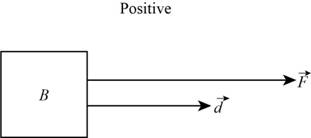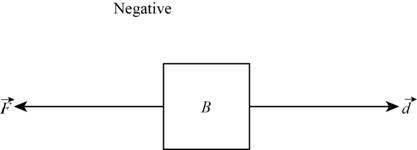
Concept explainers
Recall the definition of work done on an object by an agent that exerts a force on that object. (You may wish to consult your textbook.)
In the spaces provided, sketch arrows representing (1) a force exerted on an object and (2) the displacement of that object for cases in which the work done by the agent is:
In each case, does your sketch represent the only possible relative directions of the force and displacement vectors? If so, explain. If not, sketch at least one other possible set of vectors.
The direction of the force exerted on an object and the direction of displacement of an object for different cases.
Explanation of Solution
Introduction:
Work is the measure of energy transferred when a force is applied to move an object through a displacement. Work done by a force acting on an object is equal to the product of the magnitude of the displacement and the component of force parallel to that displacement.
When work done on an object is positive, then the direction of the force exerted on an object and the direction of displacement of an object is the same.
The direction of force and displacement of an object when the work done is positive is shown in figure 1.

Figure 1
When work done on an object is negative, then the direction of the force exerted on an object and the direction of displacement of an object is the opposite.
The direction of force and displacement of an object when work done is negative is shown in figure 2

Figure 2
When work done is zero, then, in this case, either displacement is zero or there is no change in the kinetic energy.
The direction of force and displacement of an object when the work done is negative is shown in figure 3.

Figure 3
Conclusion:
Therefore, the direction of force and displacement for positive, negative and zero work done is shown in figure 1, 2 and 3 respectively.
Want to see more full solutions like this?
Chapter 13 Solutions
Tutorials in Introductory Physics
Additional Science Textbook Solutions
University Physics Volume 1
College Physics: A Strategic Approach (4th Edition)
College Physics (10th Edition)
Physics for Scientists and Engineers: A Strategic Approach with Modern Physics (4th Edition)
Physics for Scientists and Engineers: A Strategic Approach, Vol. 1 (Chs 1-21) (4th Edition)
Physics (5th Edition)
- Whenever the answer to the "is it above or below the zero reference for height?" question is Yes, then it has gravitational potential energy at that point. If the answer is No, then its gravitational potential energy at that point is zero. In the space below, draw the LOL diagram for the cart + block motion. The first Lis for energies at the initial point of the motion. The O is for transfers of energy (by macroscopic forces doing work or microscopic interactions transferring energy through heat). The second Lis for energies at the final point of the motion. EKi Egi Esi Egf Eg A Epharrow_forwardINSTRUCTIONS: Please write clearly and understandable way. Write all the corresponding Given with their corresponding symbols and units. Draw/Illustrate the diagram/circuit or drawings that is related to the problem, IF POSSIBLE, which is HIGHLY REQUIRED. Solve in step-by-step, no shortcut. Underline twice the Final Answer. PROBLEM: Find the work done against the force of gravity in moving a rocket weighing 8 tons to a height 200 mi above the surface of the earth. A. 16000/7 mi-tons B. 32000/21 mi-tons C. 64000/21 mi-tons D. 16000/21 mi-tonsarrow_forwardProblem: given vector X = 18m, 29 degrees N of W and vector Y = 9m, 80 degress S of E Determine: X-Y (express answer in Unit vectors) *Pls answer with complete solution. *draw a graph/diagram with proper labels *THREE decimal places all final answers *enclose all final answer with a box ** I'm a little confused on how it can be solve. Can you help me? I would appreciate if you do. Thank you so mucharrow_forward
- A roller-coaster car shown in the following figure is pulled up to point 1 where it is released from rest. Assuming no friction, calculate the speed at points 2, 3, and 4. please show your work, including diagrams, algebraic equations, and enough written explanations that somebody who is not familiar with the problem could understand what you are doing.arrow_forwardTwo objects of different mass start from rest and are pulled horizontally with negligible friction by the same magnitude net force and moved through the same distance. The work done on object 1 is 4000 joules. After the force has pulled each object, object 1 is seen to move with half the speed of object 2. Answer the following questions and show your work. a. How much work is done on object 2? What is the kinetic energy of object 1 after being pulled? Explain. b. What is the kinetic energy of object 2 after being pulled? Explain. с.arrow_forwardExpress v = (8; 105°) in terms of unit vectors i and j. Include in your response a hand-drawn representation of the vector. Show all relevant working.arrow_forward
- Please answer part D of this problem, Make sure you do the right work please and provide the right answer. DO not type your work upload a picture of your work please.arrow_forwardPlease answer all the questions and give the reasoning for each of the steps you make. I sometimes can't understand some people's work so please ensure that you show the reasoning for the work. This is a non-calculator question. Please solve it without the calculator. We can simplify the answer with the trig identity.arrow_forwardTwo objects of different mass start from rest and are pulled horizontally with negligible friction by the same magnitude net force and moved through the same distance. The work done on object 1 is 4000 joules. After the force has pulled each object, object 1 is seen to move with half the speed of object 2. Answer the following questions and show your work. a. How much work is done on object 2? b. What is the kinetic energy of object 1 after being pulled? Explain. C. What is the kinetic energy of object 2 after being pulled? Explain. d. What is the ratio of the mass of object 1 to the mass of object 2? Explain and show work.arrow_forward
- 1.Use the following information to answers parts a–d. Show all your work.A baseball is batted from a height of 1.09 m with a speed of39.7 m/s at an initial angle of 17.8˚ above the horizontal.a Calculate the horizontal and vertical components of the ball’s initialvelocity.b What is the maximum height above the ground reached by the ball?Assume a level baseball field.c How far off course would the ball be carried after 2.00 s if there was a 4.0 m/scrosswind?d What is the ball’s velocity after 2.00 s if there is no crosswind?arrow_forwardA positive charge is released from rest at pt A as shown in the figure. As it accelerates towards pt B, is the charge’s electric potential energy increasing or decreasing? What about its kinetic energy? Is the work done positive or negative? Repeat part a through c if the positive charge was initially moving to the left at pt B. Solve 4. onlyarrow_forwardA force of 8 N will stretch a rubber band 4 cm (0.04 m). Assuming that Hooke's law applies, how far will a 12-N force stretch the rubber band? How much work does it take to stretch the rubber band this far? How far will a 12-N force stretch the rubber band? m (Simplify your answer.) How much work does it take to stretch the rubber band this far? J (Simplify your answer.)arrow_forward
 Principles of Physics: A Calculus-Based TextPhysicsISBN:9781133104261Author:Raymond A. Serway, John W. JewettPublisher:Cengage Learning
Principles of Physics: A Calculus-Based TextPhysicsISBN:9781133104261Author:Raymond A. Serway, John W. JewettPublisher:Cengage Learning
